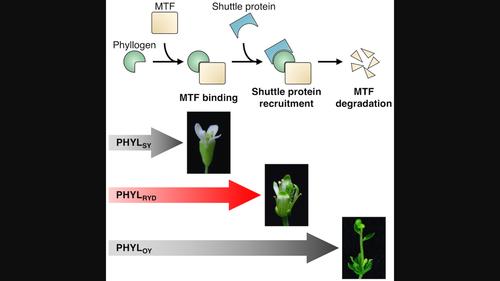当前位置:
X-MOL 学术
›
Mol. Plant Pathol.
›
论文详情
Our official English website, www.x-mol.net, welcomes your feedback! (Note: you will need to create a separate account there.)
Target degradation specificity of phytoplasma effector phyllogen is regulated by the recruitment of host proteasome shuttle protein
Molecular Plant Pathology ( IF 4.9 ) Pub Date : 2023-12-17 , DOI: 10.1111/mpp.13410 Masato Suzuki 1 , Yugo Kitazawa 1 , Nozomu Iwabuchi 1 , Kensaku Maejima 1 , Juri Matsuyama 1 , Oki Matsumoto 1 , Kenro Oshima 2 , Shigetou Namba 1 , Yasuyuki Yamaji 1
Molecular Plant Pathology ( IF 4.9 ) Pub Date : 2023-12-17 , DOI: 10.1111/mpp.13410 Masato Suzuki 1 , Yugo Kitazawa 1 , Nozomu Iwabuchi 1 , Kensaku Maejima 1 , Juri Matsuyama 1 , Oki Matsumoto 1 , Kenro Oshima 2 , Shigetou Namba 1 , Yasuyuki Yamaji 1
Affiliation

|
Phytoplasmas infect a wide variety of plants and can cause distinctive symptoms including the conversion of floral organs into leaf-like organs, known as phyllody. Phyllody is induced by an effector protein family called phyllogens, which interact with floral MADS-box transcription factors (MTFs) responsible for determining the identity of floral organs. The MTF/phyllogen complex then interacts with the proteasomal shuttle protein RADIATION SENSITIVE23 (RAD23), which facilitates delivery of the MTF/phyllogen complex to the host proteasome for MTF degradation. Previous studies have indicated that the MTF degradation specificity of phyllogens is determined by their ability to bind to MTFs. However, in the present study, we discovered a novel mechanism determining the degradation specificity through detailed functional analyses of a phyllogen homologue of rice yellow dwarf phytoplasma (PHYLRYD). PHYLRYD degraded a narrower range of floral MTFs than other phyllody-inducing phyllogens, resulting in compromised phyllody phenotypes in plants. Interestingly, PHYLRYD was able to bind to some floral MTFs that PHYLRYD was unable to efficiently degrade. However, the complex of PHYLRYD and the non-degradable MTF could not interact with RAD23. These results indicate that the MTF degradation specificity of PHYLRYD is correlated with the ability to form the MTF/PHYLRYD/RAD23 ternary complex, rather than the ability to bind to MTF. This study elucidated that phyllogen target specificity is regulated by both the MTF-binding ability and RAD23 recruitment ability of the MTF/phyllogen complex.
中文翻译:

植原体效应子系统原的目标降解特异性通过宿主蛋白酶体穿梭蛋白的招募来调节
植原体感染多种植物,并可引起独特的症状,包括将花器官转变为叶状器官,称为叶状病。Phyllody 是由称为 phyllogens 的效应蛋白家族诱导的,该家族与负责确定花器官身份的花 MADS-box 转录因子 (MTF) 相互作用。然后 MTF/系统原复合物与蛋白酶体穿梭蛋白 RADIATION SENSITIVE23 (RAD23) 相互作用,从而促进 MTF/系统原复合物递送至宿主蛋白酶体以进行 MTF 降解。先前的研究表明,系统发育原的 MTF 降解特异性是由它们与 MTF 结合的能力决定的。然而,在本研究中,我们通过对水稻黄矮植原体的系统发育同源物(PHYL RYD)的详细功能分析,发现了一种决定降解特异性的新机制。与其他叶状诱导的叶状发育原相比, PHYL RYD降解的花 MTF 范围更窄,导致植物叶状生长表型受损。有趣的是,PHYL RYD能够与一些 PHYL RYD无法有效降解的花 MTF 结合。然而,PHYL RYD和不可降解的 MTF 的复合物不能与 RAD23 相互作用。这些结果表明,PHYL RYD的MTF降解特异性与形成MTF/PHYL RYD /RAD23三元复合物的能力相关,而不是与MTF结合的能力相关。这项研究阐明,系统发育原靶标特异性受到 MTF/系统发育原复合物的 MTF 结合能力和 RAD23 招募能力的调节。
更新日期:2023-12-17
中文翻译:

植原体效应子系统原的目标降解特异性通过宿主蛋白酶体穿梭蛋白的招募来调节
植原体感染多种植物,并可引起独特的症状,包括将花器官转变为叶状器官,称为叶状病。Phyllody 是由称为 phyllogens 的效应蛋白家族诱导的,该家族与负责确定花器官身份的花 MADS-box 转录因子 (MTF) 相互作用。然后 MTF/系统原复合物与蛋白酶体穿梭蛋白 RADIATION SENSITIVE23 (RAD23) 相互作用,从而促进 MTF/系统原复合物递送至宿主蛋白酶体以进行 MTF 降解。先前的研究表明,系统发育原的 MTF 降解特异性是由它们与 MTF 结合的能力决定的。然而,在本研究中,我们通过对水稻黄矮植原体的系统发育同源物(PHYL RYD)的详细功能分析,发现了一种决定降解特异性的新机制。与其他叶状诱导的叶状发育原相比, PHYL RYD降解的花 MTF 范围更窄,导致植物叶状生长表型受损。有趣的是,PHYL RYD能够与一些 PHYL RYD无法有效降解的花 MTF 结合。然而,PHYL RYD和不可降解的 MTF 的复合物不能与 RAD23 相互作用。这些结果表明,PHYL RYD的MTF降解特异性与形成MTF/PHYL RYD /RAD23三元复合物的能力相关,而不是与MTF结合的能力相关。这项研究阐明,系统发育原靶标特异性受到 MTF/系统发育原复合物的 MTF 结合能力和 RAD23 招募能力的调节。



























 京公网安备 11010802027423号
京公网安备 11010802027423号